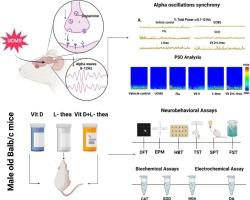Nutritional co-therapy with vitamin D and L-theanine reduces unpredictable mild chronic stress (UCMS) in aged mice by restoring alpha-oscillations, dopamine levels and behavioral improvement
IF 4.3
引用次数: 0
Abstract
Late-life depression (LLD) arises from the confluence of neurochemical dysfunction, oxidative stress, and neural network disintegration, presenting a formidable therapeutic challenge. Here, we demonstrated that combined vitamin D (Vit D) and L-theanine (L-thea) administration exerts multimodal neurorestorative effects in an aged murine model of unpredictable chronic mild stress (UCMS), addressing the core triad of LLD pathology: dopaminergic decline, redox imbalance, and thalamocortical dyssynchrony. Using a comprehensive battery of behavioral assays (Open Field Test, Elevated Plus Maze, Hole Board Test, Tail Suspension Test, Forced Swim Test, Sucrose Preference Test), we observed profound anxiogenic and anhedonic phenotypes in the UCMS-exposed mice, accompanied by elevated immobility and suppressed exploratory drive. Co-treatment with L-theanine (2 mg/kg) and vitamin D (500 IU/kg) robustly reversed these deficits, surpassing the efficacy of monotherapy (P < 0.05). Electrophysiologically, Vit D + L-thea restored alpha oscillations (8–13 Hz power: 2.33-fold increase vs. UCMS, P < 0.0001), indicating recovered thalamocortical coherence, which is a biomarker of cognitive-emotional integration. Amperometric brain homogenate analysis revealed dopaminergic recovery (Δcurrent = 1.99 μA vs. UCMS 0.66 μA), paralleled by supra-normalized antioxidant defenses as evidenced by significant reductions in MDA and enhancements in endogenous antioxidant enzymes (SOD, catalase, P < 0.0001). These convergent outcomes underscore multimodal therapeutic action of combination, targeting the GABA-glutamate balance, dopaminergic tone, oxidative stress, and cortical oscillatory stability. This combination presents a transformative approach for LLD, particularly in frail, treatment-resistant populations, where polypharmacy risks prevail. Our study bridges nutritional neuroscience and geriatric psychiatry, offering a path to resilience against the converging tides of stress and aging.

维生素D和l -茶氨酸的营养联合疗法通过恢复α振荡、多巴胺水平和行为改善,减少老年小鼠不可预测的轻度慢性应激(UCMS)
老年抑郁症(LLD)是由神经化学功能障碍、氧化应激和神经网络解体共同引起的,是一个巨大的治疗挑战。在这里,我们证明了维生素D (Vit D)和l -茶氨酸(L-thea)联合给药在不可预测的慢性轻度应激(UCMS)的老年小鼠模型中发挥多模式神经恢复作用,解决了LLD病理的核心三因素:多巴胺能下降、氧化还原失衡和丘脑皮质不同步。通过一系列综合的行为分析(开放场地测试、高架迷宫、孔板测试、悬尾测试、强迫游泳测试、蔗糖偏好测试),我们观察到暴露于ucms的小鼠存在严重的焦虑和快感缺乏表型,并伴有不动性升高和探索动力抑制。l -茶氨酸(2 mg/kg)和维生素D (500 IU/kg)联合治疗可有效逆转这些缺陷,超过单一治疗的效果(P < 0.05)。电生理学上,Vit D + L-thea恢复了α振荡(8-13 Hz功率:比UCMS增加2.33倍,P < 0.0001),表明丘脑皮质一致性恢复,这是认知-情绪整合的生物标志物。安培脑匀浆分析显示多巴胺能恢复(Δcurrent = 1.99 μA, UCMS = 0.66 μA),并伴有超标准化的抗氧化防御,如MDA显著降低和内源性抗氧化酶(SOD,过氧化氢酶,P < 0.0001)增强。这些趋同的结果强调了多模式的联合治疗作用,针对gaba -谷氨酸平衡、多巴胺能张力、氧化应激和皮层振荡稳定性。这种组合为LLD提供了一种变革性的方法,特别是在体弱多病、耐药人群中,多药风险普遍存在。我们的研究将营养神经科学和老年精神病学结合起来,为抵御压力和衰老的趋同趋势提供了一条途径。
本文章由计算机程序翻译,如有差异,请以英文原文为准。
求助全文
约1分钟内获得全文
求助全文
来源期刊

Experimental gerontology
Ageing, Biochemistry, Geriatrics and Gerontology
CiteScore
6.70
自引率
0.00%
发文量
0
审稿时长
66 days
 求助内容:
求助内容: 应助结果提醒方式:
应助结果提醒方式:


